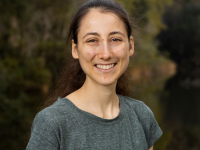Current Fellows

Camille DeSisto
Duke University (North Carolina)
Lemur-mediated restoration to advance biocultural sustainability in northeast Madagascar
Widespread environmental change is altering plant and animal populations throughout tropical forests. Such disturbances change patterns in animal seed dispersal— how fruit-eating animals spread seeds throughout landscapes. Although often overlooked in landscape restoration, animal seed dispersal can be important for conserving healthy ecosystems and ensuring sustainable access to resources for local communities. The effects of seed dispersal and, consequently, its reduction on plant populations in tropical forests depend on if a dispersed seed can successfully germinate, grow, and survive. Here, I propose to experimentally assess the effects of seed dispersal by lemurs— a highly-endangered primate taxa found only on Madagascar— on plant germination, growth, and survival in a human-modified landscape in northeastern Madagascar. I work in a collaborative team and take a biocultural approach to science by integrating both ecosystem health and human well-being. We propose to build on two previous years of data collection to examine if and how lemur seed dispersal contributes to landscape restoration. Specifically, we will 1) measure how lemur seed dispersal affects the germination, growth, and survival of different forest plant species, 2) determine the most effective locations for local restoration, and 3) identify priority plant species for habitat restoration (i.e., plants with greatest growth and survival rates, as well as plants that are important to and commonly used by local communities). Conserving and restoring key seed dispersal interactions in Madagascar may advance the well-being of both forest ecosystems and human well-being.

David Felipe Rodríguez Mora
The University of Texas at San Antonio
Tracing the Yagé (a.k.a. Ayahuasca) Tourism Lianas in Southwestern Colombia: Towards the Conservation and Sustainable Management of the Cofán Shamanism Yagé Lianas
Yagé are tropical lianas in the acerola family used in Amazonian rituals and worldwide. Western science has demonstrated the medicinal role of the compounds in some Yagé species, including anticancer, antidepressant, and neuroprotective effects. Recent findings also emphasize the therapeutic potential of Yagé for depression and severe physical illnesses, including cancer. The growing interest in Yagé has caused the emergence of Yagé tourism, a global market increasingly demanding Yagé. The lianas’ wild populations are now considered becoming rare, suggesting possible conservation risks for the lianas throughout the Amazon. Yagé tourism has also offered an important source of income for the Cofán Indigenous people in Colombia and Ecuador, and they have increased their Yagé cultivation. However, the increasing lianas demand has also caused their uncontrolled harvesting from the wild. Despite Yage’s growing interest, our understanding of the Yagé species diversity is still incomplete. Although recent botanical studies clarified some aspects of the Yagé diversity, innovative cultural studies have also pointed out important considerations of how the Cofáns understand and classify their Yagé varieties. This suggests benefits in using methods from different knowledge areas to better understand the Yagé diversity. By applying methods in ethnobotany to analysis in cultural studies, this study seeks to discover similarities and differences between the Cofán and Western science understandings of the Yagé types that the Sucumbíos Cofáns in Colombia outsource and employ in Yagé tourism. Additionally, this study intends to evaluate how the Cofáns-Yagé relationship with these outsourced lianas has changed over time.

Lauren Nerfa
University of Hawaiʻi at Mānoa
Human dimensions and ecological outcomes of long-term forest restoration in Hawaiʻi
Forests are of critical importance to society for many reasons, providing regulation of climatic patterns, erosion control, products such as building materials, access to culturally important resources such as foods and medicines, and conferring health benefits such as stress reduction. Yet loss and degradation of forests is widespread, which is a critical issue facing Pacific Islands such as Hawaiʻi. In recent years, many efforts have been undertaken to restore forests and nearby ecosystems by local governments, non-governmental organizations, and community groups. Yet the outcomes of these restoration efforts remain largely unknown due to lack of resources for scientists to monitor the characteristics of restored forests. Additionally, including human dimensions in restoration (social, cultural, community benefits) can ensure lasting success of projects, but little is known about the ways that these dimensions impact restoration outcomes. In the proposed research project, I will partner with one organization in Oʻahu, Hawaiʻi to investigate the ecological outcomes of long-term forest restoration projects using indicators that are valuable for the organization, such as plant diversity, species survival, and forest structure. I will also conduct interviews with leaders of the restoration efforts to understand the local community benefits, cultural importance of plant species, and community well-being aspects of their efforts. Together the results can provide insights on how local policy makers can best support these important restoration initiatives.

Lydia Soifer
University of Florida (Florida)
Unraveling the impact of microclimates on the biogeography of epiphytes in Panama
Climate change may threaten epiphytes, which are plants that live non-parasitically on trees such as some species of orchids, bromeliads, and ferns. However, these predictions generally depend on maps of current and future climates that may not represent the climatic conditions that epiphytes experience due to their coarse spatial scale. In tropical rainforests, microclimate variation from the understory to the upper canopy and across elevations influences where different epiphyte species occur. For example, shadier, cooler, and wetter microhabitats in the inner canopy contain different epiphyte species than sunnier, hotter, and drier microhabitats in the outer canopy. Yet, we do not have a good understanding of how these microclimates may influence vulnerability of epiphytes to climate change. I therefore propose to examine impacts of microclimates on epiphytes under current and future climate conditions across a mountain slope in Cerro Chucanti Reserve in the Darien Province of Panama to improve predictions of climate change impacts. To do so, I will monitor microclimate variation in the forest canopy across elevations, predict future microclimates based on these measurements, and examine how microclimates influence epiphyte distributions across the mountain slope. The results of the research will improve our understanding of the mechanisms driving patterns of epiphyte diversity and how climate change may impact epiphyte communities in the future.

N. Miller
Lehigh University (Pennsylvania)
Exploring the interactions between canopy gaps and invasive plant communities in northeastern hardwood forests
This study looks at how invasive plants affect the lower layer of deciduous forests, the area beneath the main tree canopy. Invasive plants are plants that have been introduced to an ecosystem where they don’t naturally occur, which out-compete and harm the native species when left unchecked. We want to understand how these invasive species spread within a forest. We ask: How do gaps in tree cover affect the ability of invasive species to establish and spread in a healthy forest? How does the variety of plants in the understory change over time in these gaps when invasive species are present? Does the proportion of shrubs, vines, and non-woody plants change when a canopy gap becomes invaded? To find out, we plan to observe and record the variety of small plants like shrubs, herbs, and vines in different openings in Allegheny National Forest. We'll look at gaps of various ages to capture the progress of succession– the process through which an ecosystem recovers from a disturbance. This study aims to answer an important question that hasn't been explored much: How do the smaller plants in deciduous forests react when there are more disturbances (like gaps in the trees) and more invasive species? Our findings will help us understand: 1) how the community of plants within a forest changes as more invasive species establish, 2) how the time since a disturbance influences how many invasive species are present, and 3) where invasive species are the most concentrated within a forest gap.

Richard Hull
Indiana University (Indiana)
Identifying Changes in the Wabash River’s Vascular Plant Flora
Vascular plants are one of the most important organism groups on Earth. There are over 340,000 species worldwide, which collectively provide food and habitat to all terrestrial animals. Despite their importance, vascular plants are under threat from two intensifying human-caused forces: Non-native species and climate change. Furthermore, how these two stressors have impacted the distributions of vascular plant species in the United States since the early 1900’s is largely unknown. Here I outline a study that is documenting the current flora of the lower Indiana Wabash River corridor in order to determine how it has changed since it was last documented by Charles and Stella Deam from 1896–1952. The findings from this analysis will be used to construct predictions of the region’s rare flora for the years 2050 and 2080 under two different forecasted climate scenarios. This data, in combination with current updates on rare and non-native species in this region, will be used to generate a conservation plan for the region’s native flora that will be shared with the Indiana Plant Conservation Alliance, the Indiana Department of Natural Resources, and several Indiana land trusts. Overall, this study will inform and prepare these organizations for the effects that exotic species and climate change will have on the Indiana flora, while also demonstrating past responses these forces have had on the native flora in order to better predict native species’ future distributions and conservation needs.

Viviana Londoño-Lemos
University of Minnesota
Exploring the Tropical Dry Forest Soil Seed Bank: The Hidden Savings for the Future
Plants, much like people, plan for the future. When a forest plant scatters its seeds to the ground, some germinate immediately, while others linger in the soil, creating the soil seed bank. Understanding how soil seed banks form and vary and why some seeds endure for months while others persist for years helps ecologists grasp how vulnerable ecosystems are to deforestation and how rapidly they recover after disturbances. Soil seed bank studies are critical in highly threatened ecosystems where restoration efforts are focused, such as tropical dry forests (TDF). Despite their tropical location, TDFs experience highly seasonal rainfall, which offers an excellent opportunity to study soil seed banks. My research focuses on uncovering which TDF seeds remain in the soil seed bank and for how long. The results will help me predict how these forests regenerate and how dry and rainy seasons affect the seeds underground and their future. I hypothesize that seed traits —like size, shape, and weight— will dictate which plants endure in the soil seed bank and for how long. Additionally, I propose that, depending on the severity of the dry season and the forest’s location, we can predict how long seeds persist in the soil seed bank. Through experiments with seeds from various TDF plants and soil sampling in different forests, I aim to unveil the seasonal and geographic variations of the TDF soil seed bank. Ultimately, this understanding will guide more effective restoration and recovery strategies for this unique tropical forest.
Top photo © Paul g. Wiegman




